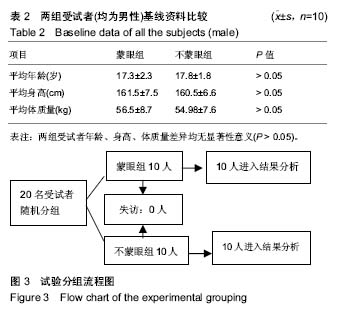中国组织工程研究 ›› 2019, Vol. 23 ›› Issue (15): 2338-2344.doi: 10.3969/j.issn.2095-4344.1162
• 肌肉肌腱韧带组织构建 tissue construction of the muscle, tendon and ligament • 上一篇 下一篇
视觉剥夺状态阶梯动作下肢肌肉组织刚度调节及肌电变化
彭远秋
- (西南医科大学体育学院,四川省泸州市 646000)
Muscle stiffness regulation and electromyographic changes of the lower limbs during descending stairs after visual deprivation
Peng Yuanqiu
- (College of Physical Education, Southwest Medical University, Luzhou 646000, Sichuan Province, China)
摘要:
文章快速阅读:
.jpg) 文题释义:
刚度概述:在生物力学研究中,人体运动刚度可分为3种,即垂直刚度、下肢刚度或者腿刚度及关节刚度。其中,垂直刚度用于动作特征仅具垂直方向的动作,它描述单纯垂直方向的线性运动效能,如双脚及单脚垂直跳;而下肢刚度则可运用于同时兼具水平及垂直方向的动作特征,如跑步或前后、左右等有方向性的跳跃时,下肢接触地面的角度及人体重心质量并非仅垂直作用于地面的情形;此外,关节刚度则是以动作过程中,下肢各关节的动作角度变化及下肢各关节肌群参与执行动作的净力矩,以决定地面反作用力的大小,关节刚度的调控对于垂直刚度及下肢刚度的影响亦有所关联。故下肢刚度及关节刚度对于提升运动表现及降低运动伤害发生,相较于垂直刚度来说更具应用价值。
刚度调节:人体在不同软硬表面上着地,质地越软,人体下肢刚度越高,且软地会延缓撞击力峰值的出现,故下肢刚度的调节是人体对运动型态与环境变化做出的动态反应,其目的在于维持运动的稳定状态并避免伤害。伴随着着地动作后紧接着往另一运动方向的移动,如跳跃或移位,这个着地后连接后续动作的时间点往往正是伤害发生频繁最高的关键时刻。
文题释义:
刚度概述:在生物力学研究中,人体运动刚度可分为3种,即垂直刚度、下肢刚度或者腿刚度及关节刚度。其中,垂直刚度用于动作特征仅具垂直方向的动作,它描述单纯垂直方向的线性运动效能,如双脚及单脚垂直跳;而下肢刚度则可运用于同时兼具水平及垂直方向的动作特征,如跑步或前后、左右等有方向性的跳跃时,下肢接触地面的角度及人体重心质量并非仅垂直作用于地面的情形;此外,关节刚度则是以动作过程中,下肢各关节的动作角度变化及下肢各关节肌群参与执行动作的净力矩,以决定地面反作用力的大小,关节刚度的调控对于垂直刚度及下肢刚度的影响亦有所关联。故下肢刚度及关节刚度对于提升运动表现及降低运动伤害发生,相较于垂直刚度来说更具应用价值。
刚度调节:人体在不同软硬表面上着地,质地越软,人体下肢刚度越高,且软地会延缓撞击力峰值的出现,故下肢刚度的调节是人体对运动型态与环境变化做出的动态反应,其目的在于维持运动的稳定状态并避免伤害。伴随着着地动作后紧接着往另一运动方向的移动,如跳跃或移位,这个着地后连接后续动作的时间点往往正是伤害发生频繁最高的关键时刻。
.jpg) 文题释义:
刚度概述:在生物力学研究中,人体运动刚度可分为3种,即垂直刚度、下肢刚度或者腿刚度及关节刚度。其中,垂直刚度用于动作特征仅具垂直方向的动作,它描述单纯垂直方向的线性运动效能,如双脚及单脚垂直跳;而下肢刚度则可运用于同时兼具水平及垂直方向的动作特征,如跑步或前后、左右等有方向性的跳跃时,下肢接触地面的角度及人体重心质量并非仅垂直作用于地面的情形;此外,关节刚度则是以动作过程中,下肢各关节的动作角度变化及下肢各关节肌群参与执行动作的净力矩,以决定地面反作用力的大小,关节刚度的调控对于垂直刚度及下肢刚度的影响亦有所关联。故下肢刚度及关节刚度对于提升运动表现及降低运动伤害发生,相较于垂直刚度来说更具应用价值。
刚度调节:人体在不同软硬表面上着地,质地越软,人体下肢刚度越高,且软地会延缓撞击力峰值的出现,故下肢刚度的调节是人体对运动型态与环境变化做出的动态反应,其目的在于维持运动的稳定状态并避免伤害。伴随着着地动作后紧接着往另一运动方向的移动,如跳跃或移位,这个着地后连接后续动作的时间点往往正是伤害发生频繁最高的关键时刻。
文题释义:
刚度概述:在生物力学研究中,人体运动刚度可分为3种,即垂直刚度、下肢刚度或者腿刚度及关节刚度。其中,垂直刚度用于动作特征仅具垂直方向的动作,它描述单纯垂直方向的线性运动效能,如双脚及单脚垂直跳;而下肢刚度则可运用于同时兼具水平及垂直方向的动作特征,如跑步或前后、左右等有方向性的跳跃时,下肢接触地面的角度及人体重心质量并非仅垂直作用于地面的情形;此外,关节刚度则是以动作过程中,下肢各关节的动作角度变化及下肢各关节肌群参与执行动作的净力矩,以决定地面反作用力的大小,关节刚度的调控对于垂直刚度及下肢刚度的影响亦有所关联。故下肢刚度及关节刚度对于提升运动表现及降低运动伤害发生,相较于垂直刚度来说更具应用价值。
刚度调节:人体在不同软硬表面上着地,质地越软,人体下肢刚度越高,且软地会延缓撞击力峰值的出现,故下肢刚度的调节是人体对运动型态与环境变化做出的动态反应,其目的在于维持运动的稳定状态并避免伤害。伴随着着地动作后紧接着往另一运动方向的移动,如跳跃或移位,这个着地后连接后续动作的时间点往往正是伤害发生频繁最高的关键时刻。摘要
背景:人体平衡与控制有赖于内耳前庭系统、本体感受器及视觉系统的协调及中枢神经系统等共同配合才能完成,但蒙眼(视觉剥夺)所引发的神经控制与感觉统合变化对下肢肌肉刚度调节能力及动作控制策略并不清楚。
目的:比较蒙眼与不蒙眼两种情况下下阶梯动作过程中下肢肌肉组织的刚度及肌电变化,从而揭示视觉对青少年神经肌肉控制及刚度的调节作用。
方法:将20名视力正常的青少年随机分成蒙眼及不蒙眼组各10人,要求两组受试者分别在3种不同高度(20,30,40 cm)下阶梯并在着地后尽最大用力实施蹲踞跳。所有受试者被要求每个动作做3次,取动作最为自然的一次进行分析。运用视迅运动图像解析系统、JP6060多维测力平台及JE-TB0810八通道无线表面肌电测试系统对受试者下阶梯动作进行运动学(着地膝角与着地踝角)、动力学(关节刚度与下肢刚度)及肌电(股直肌、股二头肌、胫骨前肌、腓肠肌)测试,并运用SPSS 17.0统计分析软件对相关指标进行处理。
结果与结论:①3种不同高度下阶梯着地瞬间:蒙眼组膝、踝角显著大于不蒙眼组,着地时反作用力出现峰值瞬间蒙眼组膝角小于不蒙眼组,而蒙眼组踝角表现与阶梯高度有关;②不同高度着地垂直力第1峰值大小及相对值:均表现为不蒙眼组显著大于蒙眼组,且两值随着阶梯高度增加而显著增加;③不同高度着地下肢膝关节刚度及下肢刚度:均表现为不蒙眼组显著大于蒙眼组,且随着阶梯高度的上升两种刚度均呈显著增加趋势;④不同高度着地前期,股二头肌、胫骨前肌及腓肠肌肌电活动:均表现为不蒙眼组显著高于蒙眼组,而在缓冲期,蒙眼组股直肌、股二头肌、胫骨前肌、腓肠肌的肌电活动均显著小于不蒙眼组;⑤结果说明,蒙眼组在不同高度下阶梯过程中,因无视觉回馈,会降低辨别与环境观测能力,这种由于视力不足,会导致实施动作时无法提供信息给中枢神经系统,而造成相关动作表现力显著下降。
中国组织工程研究杂志出版内容重点:组织构建;骨细胞;软骨细胞;细胞培养;成纤维细胞;血管内皮细胞;骨质疏松;组织工程
ORCID: 0000-0003-0295-8020(彭远秋)
中图分类号:


.jpg)
.jpg)
.jpg) 文题释义:
刚度概述:在生物力学研究中,人体运动刚度可分为3种,即垂直刚度、下肢刚度或者腿刚度及关节刚度。其中,垂直刚度用于动作特征仅具垂直方向的动作,它描述单纯垂直方向的线性运动效能,如双脚及单脚垂直跳;而下肢刚度则可运用于同时兼具水平及垂直方向的动作特征,如跑步或前后、左右等有方向性的跳跃时,下肢接触地面的角度及人体重心质量并非仅垂直作用于地面的情形;此外,关节刚度则是以动作过程中,下肢各关节的动作角度变化及下肢各关节肌群参与执行动作的净力矩,以决定地面反作用力的大小,关节刚度的调控对于垂直刚度及下肢刚度的影响亦有所关联。故下肢刚度及关节刚度对于提升运动表现及降低运动伤害发生,相较于垂直刚度来说更具应用价值。
刚度调节:人体在不同软硬表面上着地,质地越软,人体下肢刚度越高,且软地会延缓撞击力峰值的出现,故下肢刚度的调节是人体对运动型态与环境变化做出的动态反应,其目的在于维持运动的稳定状态并避免伤害。伴随着着地动作后紧接着往另一运动方向的移动,如跳跃或移位,这个着地后连接后续动作的时间点往往正是伤害发生频繁最高的关键时刻。
文题释义:
刚度概述:在生物力学研究中,人体运动刚度可分为3种,即垂直刚度、下肢刚度或者腿刚度及关节刚度。其中,垂直刚度用于动作特征仅具垂直方向的动作,它描述单纯垂直方向的线性运动效能,如双脚及单脚垂直跳;而下肢刚度则可运用于同时兼具水平及垂直方向的动作特征,如跑步或前后、左右等有方向性的跳跃时,下肢接触地面的角度及人体重心质量并非仅垂直作用于地面的情形;此外,关节刚度则是以动作过程中,下肢各关节的动作角度变化及下肢各关节肌群参与执行动作的净力矩,以决定地面反作用力的大小,关节刚度的调控对于垂直刚度及下肢刚度的影响亦有所关联。故下肢刚度及关节刚度对于提升运动表现及降低运动伤害发生,相较于垂直刚度来说更具应用价值。
刚度调节:人体在不同软硬表面上着地,质地越软,人体下肢刚度越高,且软地会延缓撞击力峰值的出现,故下肢刚度的调节是人体对运动型态与环境变化做出的动态反应,其目的在于维持运动的稳定状态并避免伤害。伴随着着地动作后紧接着往另一运动方向的移动,如跳跃或移位,这个着地后连接后续动作的时间点往往正是伤害发生频繁最高的关键时刻。